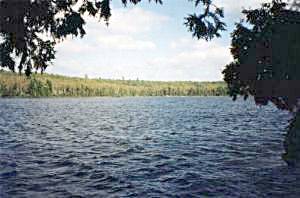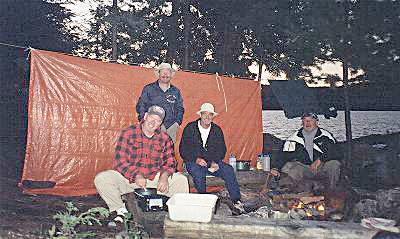|
Wed. Sept 11
Route Paddled: Maple Lake to Ratrap Lake, Dahinda Lake, Boggy Lake, N. Sylvia Lake and Three Mile Lake
Distance Paddled: 3.5 km = 2.2 miles
Distance Portaged: 3530 metres (3.5 km x 3 = 10.5 km OR 2.2 x 3 = 6.6 miles)
Weather: Damp from the night rains with seasonal temperatures and winds
By 6:30 am, the rain had finally surrendered and everyone awoke with the same idea of briskly packing within the tents prior to creeping out to face the damp, cold morning with heavy clouds and strong winds. Our breaths condensed in the crisp air. In a short while, a blue sky and sun slowly appeared; however, the wind did not relent. Over a fortified "voyageur" style breakfast, we listened as John related the loss of his flashlight, with its dead battery, in the bushes during a night’s "call to nature". Nearly blind without his glasses, John, in a low voice sought out Wayne for help in getting back to his tent. We vowed next year to duct tape a fresh flashlight to John each night for his own safety.
8:46 am - and a moment of silence in remembrance of last year’s horrific tragedy at the World Trade Centre in New York City. Along the rocky shoreline next to a misty, but quiet Maple Lake, it was not difficult to recall the moment we were informed by cottage owners on Threenarrow Lake of that eventful day during last year’s trip.
By 9 am, we had paddled the one hundred or more metres to our portage (10P440) to Ratrap Lake – a rather intriguing name, to say the least. The air was cool and alive with the fragrant smells of the forest as we traipsed along the rain-soaked trail. Crossing the lake, we paddled towards what we thought was the portage sign, only to discover a faded campsite sign. We consulted our map and redirected our canoes through a narrow channel strewn with logs and rocks. Entering and rounding a point on Dahinda Lake, we immediately saw the portage sign (11P1135) to Boggy Lake, a name that left us with some tribulation as to what we might soon encounter! The take-out had to be the muddiest en route.
Halfway through the portage, we found ourselves on a gravel maintenance road – to our dismay someone had ripped a portage sign in half and poked holes in another further down the road where the portage continued into the woods. We attempted to repair the damaged sign as best as we could. It was truly disheartening to realize that someone could trip into the confines of Algonquin, or any other park, and do something as destructive and irresponsible as this – with no appreciation of the potential hazards inflicted upon other canoeists – just plain ignorance and stupidity. The situation did not improve at the end of the portage at Boggy Lake where another damaged portage sign that had been repaired with duct tape by another canoeist was found – this matter, as well as the fallen trees strewn over pathways, were reported to park officials at the end of our trip.
Upon returning for our canoes, we met John Leto carrying his canoe while his wife was somewhere behind him slugging with the heavy backpack – they seemed to manage very comfortably under their system. Boggy Lake did not live up to its name – it was a small, picturesque lake with no bog in sight. The trek (12P455) to N. Sylvia Lake was easy going and upon our return for the canoes, we met the Letos again and gave them the lead since we were ahead of schedule and leisurely enjoying the day. Later, we all met on the sandy beach of N. Sylvia Lake and lunched together, getting better acquainted and exchanging stories of past canoe trips.
In their light canoe, the Letos were hampered by the strong headwinds and we soon overtook them on the open lake. At the last portage, tucked out of the way in a small lagoon, was our destination to Three Mile Lake (13P500). Norm H took a classic photograph of John pretending to hold up a huge, leaning elm tree over his unprotected canoe. We had just commenced our portage when we met the Letos trying to clamber over a fallen, red maple across the pathway. A strong smell of maple sap hung in the air and it was presumed that a wind-burst had fallen the tree during the previous evening’s thunderstorm.
 John Leto took the lead again and at the end of the portage, we said our "adieux" for they were paddling south to a remote island while we intended on camping on the opposite side of Three Mile Lake. John Leto took the lead again and at the end of the portage, we said our "adieux" for they were paddling south to a remote island while we intended on camping on the opposite side of Three Mile Lake.
In Algonquin Park, the increase in afternoon winds were always predictable, so we made haste to traverse Three Mile Lake. Paddling in unison, we soured our canoes forward at a safe angle, splitting the foaming white-capped waves before tacking downwind towards the first campsite. Prying and drawing our paddles towards the rocky shore, we landed safely and wisely chose this site as our home for the night. In no time, the lake became turbulent – a condition that stayed consistent for the remainder of the afternoon.
It was only 2 pm and already the temperature had decreased to 16-degrees C, but this didn’t deter Norm H and John from going for a swim. The water was warmer than the atmosphere; however, it was a "killer" getting out of the water and into warm clothes - this inspired us to set up the large tarp next to the campfire as a wind buffer.
 Wayne became enthralled with splitting firewood for the cold evening’s as well as the next morning’s fire, after he located a weathered, white cedar leaning precariously along the shore. It must have been there for many years because upon the first split of the axe, the strong scent of cedar was evident everywhere. As the sun began to set, the two Norms ventured into the woods towards the adjoining cove to take photos. As we sat around the campfire, we could hear a flock of Canadian Geese honking over the lake, winging their way to southward nesting grounds – the migration and the crisp, night air were a sure sign of autumn. Wayne became enthralled with splitting firewood for the cold evening’s as well as the next morning’s fire, after he located a weathered, white cedar leaning precariously along the shore. It must have been there for many years because upon the first split of the axe, the strong scent of cedar was evident everywhere. As the sun began to set, the two Norms ventured into the woods towards the adjoining cove to take photos. As we sat around the campfire, we could hear a flock of Canadian Geese honking over the lake, winging their way to southward nesting grounds – the migration and the crisp, night air were a sure sign of autumn.
|